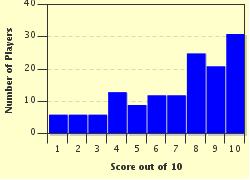Quiz Answer Key and Fun Facts
1. Here are four statements about Nicodemus. Which one is incorrect?
2. Here are four statements about John the Baptist. Which one is incorrect?
3. Here are four statements about Herodias. Which one is incorrect?
4. Here are four statements about Pontius Pilate. Which one is incorrect?
5. Here are four statements about Herod the Great. Which one is incorrect?
6. Here are four statements about the Ethiopian eunuch. Which one is incorrect?
7. Here are four statements about Rhoda. Which one is incorrect?
8. Here are four statements about the Samaritan woman at the well. Which one is incorrect?
9. Here are four statements about the leper who was cleansed by Jesus and returned to give thanks. Which one is incorrect?
10. Here are four statements about the woman who touched Christ's gown and was made well. Which one is incorrect?
Source: Author
Cowrofl
This quiz was reviewed by FunTrivia editor
LeoDaVinci before going online.
Any errors found in FunTrivia content are routinely corrected through our feedback system.

